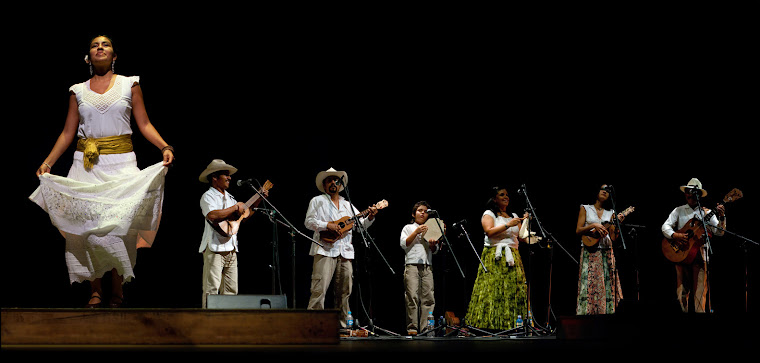El Son Jarocho es un género musical campesino de la región del Sotavento, llanos y sur de Veracruz. Históricamente, se gesta y enriquece con el ir y venir de formas literarias y musicales de muy diferente signo, como la aportación de los cancioneros de la España andaluza, árabe y gitana con la cultura del mestizaje.
La familia Utrera comandada por don Esteban Utrera Lucho nacido en el año 1920, campesino y requintista, se conformó como agrupación en el año 1992 y desde entonces se ha dedicado a la promoción de este género, participando en foros nacionales e internacionales, interpretando los sones jarochos tradicionales apegados a la herencia de esta familia.
Los sones jarochos dan vida a los fandangos o huapangos, festejos populares en donde se canta, baila o toca algún instrumento alrededor de la tarima, con la participación de la comunidad.
Así, música, verso y tablado, comida y bebidas como el “torito” (alcohol de caña y frutas naturales) son elementos con los que un fandango puede durar varios días.
HISTORIA
Este grupo nace con la idea de asistir a los Encuentros de Jaraneros y Fandangos con el estilo que le caracteriza, siendo su primer experiencia Tlacotalpan, Veracruz. Don Esteban con sus hijos Camerino y Tacho Utrera, sus sobrinos Darmacio Cobos Utrera, Esmeralda y Martha Cobos Vidaña, Angel Romero Cobos y Wendy Cao Romero.
En los 17 años que llevan conformados, han participado diferentes amigos que admiran a Don Esteban y al estilo que le caracteriza a esta familia. Entre ellos: Alejandra Hernández, Leopoldo Novoa, Octavio Rebolledo, Alfredo Herrera, Diego Corvalán, Cesar Castro, Alec Dempster, Kali Niño y Adriana Cao Romero.

fotografía: rodrigo vázquez
ENGLISH
“Son Jarocho” and the “Fandango” are part of the popular culture of the southern area of the state of Veracruz, and occur in rural communities as well as in the cities of the Sotavento region. “Son Jarocho” is a regional genre, which resulted from the meeting of three worlds (Spanish, African and Indigenous). Its ritual space is the “Fandango de Tarima”. About 40 “Sones” are interpreted In present days during the “Fandangos”, however in the nineteenth century the repertoire consisted of about 100 airs and melodies of diverse origins: most of them were danced by one or more couples and others “De a Montón” were danced by women. Variations often included choreography related to the subject matter of the “Son”.
The instrumentation used during the nineteenth century can still be observed. It consists of “Jaranas” of different sizes, (an adaptation of the Italian baroque
guitar from that period) which are strummed and define the harmonic structure. The essential melodic component is played on the “Guitarra de Son”, a small four stringed guitar that is plucked with a specially crafted piece of bull’s horn. It descends from the sixteenth century bandola and is related to other Latin-American instruments such as the Venezuelan "Bandola", the Puerto Rican "Cuatro", and the Cuban "Tres".
The diatonic harp has also been added to these instruments. A few percussion instruments are also used such as the donkey jaw, the hexagonal pandero(frame drum) and the recently introduced marimbol, but the most important is the “Tarima”.
The instrumentation and the subject matter of its lyrics reveal a strong Caribbean nature, which it shares with rural music from Cuba, Puerto Rico, The Dominican Republic, Venezuela and the Canary Islands.
Today, Son Jarocho is the result of a cultural exchange that has lasted several centuries.

fotografía: rodrigo vázquez
